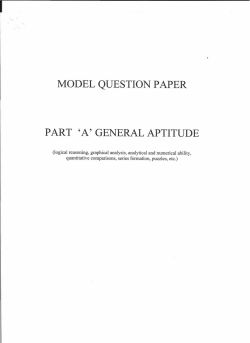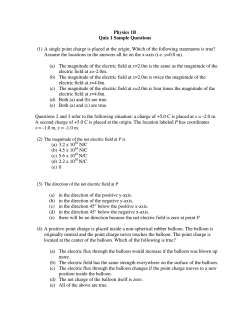
Homework 7: Linear Dielectrics outside of the dielectric
Homework 7: Linear Dielectrics
1. [10 points] In class, we showed that the electric potential produced by a polarized
dielectric for points outside of the dielectric was given by
Prove that the electric potential produced by a polarized dielectric for points inside of the
dielectric is also given by
where the integral runs over the entire volume of the dielectric.
[Hint: To show this, you need to use the result from Homework #6, Problem 2]
Answer: Suppose we want to determine the macroscopic electric field at some point within a
dielectric. By definition, the macroscopic field is the average electric field over a region large
enough so that the polarization within the region remains constant. To define this macroscsopic
field, suppose we place a Gaussian sphere within the dielectric that’s just large enough so that
the polarization within this sphere is constant. Thus, the macroscopic field at some point within
the dielectric consists of two parts: the average field over the sphere due to all charges outside
the region and the average field over the sphere due to all the charges inside:
⃗
⃗
⃗
From Homework #6, Problem 2, the average field over a sphere, produced by charges outside the
sphere, is equal to the electric field they produce at the center of the sphere. Therefore, ⃗
is
the electric field due to dipoles outside of the sphere. These charges are far enough away that we
can use the multipole expansion to determine the electric potential
where the integration is performed over all space outside the sphere. For the dipoles within
sphere, Homework #6, Problem 2 states that the average field over a sphere due to dipoles within
the sphere is given by
⃗
⃗
Since our Gaussian sphere is small enough that the polarization is essentially constant, this
implies that average field over any sphere due to charges inside the sphere is the same as the
electric field at the center of uniformly polarized sphere. Thus, the total macroscopic field is
given by the potential
where the integral is evaluated over the entire volume of the dielectric.
2. [10 points] A conducting spherical shell has inner radius a and outer radius c. The space
between these two surfaces is filled with a dielectric for which the dielectric constant is
between a and b, and
between b and c, as shown below. Determine the capacitance
of the system and the energy stored in the system.
Answer:
To find the electric field in the region
apply Gauss’s law
, we draw a Gaussian sphere of this radius and
∮⃗
⃗
̂
Based on linear dielectric theory, we have
⃗
In the region
⃗
⃗
⃗
̂
, we draw a Gaussian sphere of this radius and apply Gauss’s law
∮⃗
⃗
̂
Based on linear dielectric theory, we have
⃗
⃗
⃗
⃗
̂
To find the potential difference, we have
∫ ⃗
∫
∫
[
(
)
(
)]
Therefore, the capacitance is given by
[
(
)
(
)]
The energy of this configuration is given by
(
(
)
[
(
)
)
(
)]
[
(
)
(
)]
3. A point charge q is imbedded at the center of a sphere of linear dielectric material with
susceptibility χe and radius R.
a. [4 points] Find the electric field and the polarization.
b. [4 points] Find the bound charge densities
and . What is the total bound
charge on the surface?
c. [2 points] Where is the compensating negative bound charge located?
Answer:
(a) To find the electric field, we can apply Gauss’s law in the presence of a dielectric
∮⃗
⃗
̂
Based on linear dielectric theory, we have
⃗
⃗
⃗
(
)
(
̂
)
The polarization is given by
⃗
⃗
(
)
̂
(b) The volume bound charge is given by
⃗
(
)
̂
( )
Recall the definition of the Dirac-Delta function
̂
( )
( )
Therefore, the volume bound charge is given by
⃗
(
̂
( )
)
(
The surface bound charge is given by
⃗
̂
(
)
The total bound charge on the surface is given by
(
)
)
( )
Since the volume bound charge is zero everywhere except at the center, this implies that
the compensating negative charge must be at the center. To show this, note that
∫
∫
( )
4. [10 points] An uncharged conducting sphere of radius a is coated with a thick insulating
shell of dielectric constant
out to radius b. This object is now placed in a uniform
electric field ⃗
̂ . Find the electric field in the insulator and outside the dielectric
sphere.
[Hint: Note that for points far from the sphere
]
Answer:
To determine the electric field, we will use separation of variables in spherical coordinates. The
azimuthally-symmetric general solution to Laplace’s equation is given by
(
)
) (
∑(
)
We note that since there is a zero net charge inside the dielectric sphere, this implies that
for
. Since
for points far outside the sphere, this implies that
(
)
(
∑
)
Therefore the general solution with these boundary conditions is
(
)
) (
∑(
∑
{
)
(
)
To determine the coefficients, we note that the potential must be continuous at
implies that
( )
We note that the potential must be continuous at
. This implies that
( )
(
(
)
)
( )
. This
Finally, we note that the normal derivative of the potential undergoes a discontinuity at
∑(
For
(
) (
)
)
)
∑(
(
)
.
( )
, we have [using (1)]
(
(
[(
)
)
)
(
)
]
( )
Comparing (4) with (3) gives
[(
)
]
(
)
Using these results, we can write (2) as
(
We can now simplify (4) for
(
)
( )
as
(
)
)
Using (5) gives us
[
(
)
[
]
( ) ]
(
[
)
( ) ]
Therefore, the electric potential inside the dielectric is given by
(
)
) (
∑(
)
(
(
[
( ) ]
[
( ) ]
)
)
The electric field inside the insulator is given by
⃗
(
)
[
( ) ]
[
{(
)
(
)
̂
(
)
( ) ]
The electric potential outside the sphere is given by
(
)
(
∑
(
)
(
)
)
(
[
Since
( ) ]
)
[
( ) ]
outside the dielectric, we have
(
)
(
(
)
)
(
)
The electric field outside the sphere is given by
⃗
(
)
[(
)
̂
(
)
̂]
̂}
5. The space between the plates of a parallel-plate capacitor is filled with two slabs of linear
dielectric material, as shown below. Each slab has a thickness a so the total distance
between the plates is 2a. Slab 1 has a dielectric constant of 2, and slab 2 has a dielectric
constant of 1.5. The free charge density on the top plate is and the free charge density
on the bottom plate is – .
a. [5 points] Find ⃗ , ⃗ , and ⃗ in each slab.
b. [3 points] Find the location and amount of all bound charge.
c. [2 points] Find the potential difference between the plates
Answer:
(a) The electric displacement can be obtained from Gauss’s law
∮⃗
By symmetry, the electric displacement only points in the z-direction and thus, there is no
contribution from the curved wall of our Gaussian surface. Therefore, we have
∮⃗
The electric displacement from the top plate is ⃗
(
) ̂ above the top plate and is
⃗
(
) ( ̂ ) below the top plate. Similarly, the contribution from the bottom plate is
⃗
(
) ̂ below the bottom plate and ⃗
(
) ( ̂ ) above the bottom plate. Since
the displacement is a constant, the sum of the contributions cancels all displacement
outside the capacitor and gives ⃗
̂ inside the capacitor (pointing downward).
Therefore, the displacement has the same value and direction in either dielectric.
Using linear dielectric theory, the electric field in the top slab is given by
⃗
̂
⃗
̂
̂
where it is assumed that ̂ points downward. The polarization in each slab is given by
⃗
⃗
(
)⃗
̂
⃗
⃗
(
)⃗
̂
(b) Since the polarization is uniform in each slab, then the volume bound charge will be zero
in each slab. This means that there will be surface bound charge on the top and bottom of
both slabs. The surface bound charge for slab 1 is given by
{
{
The surface bound charge for slab 2 is given by
{
{
(c) The potential difference between both plates is due solely to the bound charge and is
given by
(
)
Bonus [7 points]: Consider a linear dielectric material composed of nonpolar molecules. Here,
you are going to derive a relationship between the atomic polarizability
and the electric
susceptibility . Here are the steps to this derivation:
a. First, we need to examine the total macroscopic electric field in the medium. Suppose
that the space allotted to each atom is a sphere of radius R. Show that the macroscopic
field for the dielectric material is given by
⃗
⃗
⃗
)⃗
(
where N is the number of atoms per unit volume and ⃗
sphere due to the atom itself.
is the average field over the
b. Use the result from (a) to conclude that
(
)
This result is known as the Clausius-Mossotti formula.
Answer: The macroscopic field is due to everything except the particular atom under
consideration and due to atom itself. This gives
⃗
⃗
⃗
We know that the electric field outside of the atom will be related to the polarization
⃗
⃗
⃗
Where N is the density of atoms. Based on Homework #6, Problem 2, we know that the average
field over a sphere due to charges inside the sphere is given by
⃗
⃗
Therefore, the electric field is given by
⃗
⃗
⃗
⃗
⃗
)⃗
(
The polarization is given by
⃗
⃗
⃗
(
Using linear dielectric theory, we have
)
(
)⃗
⃗
⃗
⃗
(
Solving for
)
(
)
gives
(
)
© Copyright 2025
















